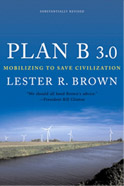Okay, here’s a slightly different modeling challenge. It might be more of a visualization challenge. Whatever. In part 1, I suggested we use requirements analysis techniques to identify stakeholders, and stakeholder goals, and link them to the various suggested “wedges“.
Here, I want to suggest something different. There are several excellent books that attempt to address the “how will we do it?” challenge. They each set out a set of suggested solutions, add up the contribution of each solution to reducing emissions, assess the feasibility of each solution, add up all the numbers, and attempt to make some strategic recommendations. But each book makes different input assumptions, focusses on slightly different kinds of solutions, and ends up with different recommendations (but they also agree on many things).
Here are the four books:

George Monbiot, Heat: How to Stop the Planet from Burning. This is probably the best book I have ever read on global warming. It’s brilliantly researched, passionate, and doesn’t pull it’s punches. Plus it’s furiously upbeat – Monbiot takes on the challenge of how we get to 90% emissions reduction, and shows that it is possible (although you kind of have to imagine a world in which politicians are willing to do the right thing).
 Joseph Romm, Hell and High Water: Global Warming–the Solution and the Politics–and What We Should Do. While lacking Monbiot’s compelling writing style, Romm makes up by being an insider – he was an energy policy wonk in the Clinton administration. The other contrast is Monbiot is British, and focusses mainly on British examples, Romm is American and focusses on US example. The cultural contrasts are interesting.
Joseph Romm, Hell and High Water: Global Warming–the Solution and the Politics–and What We Should Do. While lacking Monbiot’s compelling writing style, Romm makes up by being an insider – he was an energy policy wonk in the Clinton administration. The other contrast is Monbiot is British, and focusses mainly on British examples, Romm is American and focusses on US example. The cultural contrasts are interesting.
 David MacKay, Sustainable Energy – Without the Hot Air. Okay, so I haven’t read this one yet, but it got a glowing write-up on Boing Boing . Oh, and it’s available as a free download.
David MacKay, Sustainable Energy – Without the Hot Air. Okay, so I haven’t read this one yet, but it got a glowing write-up on Boing Boing . Oh, and it’s available as a free download.
 Lester Brown, Plan B 3.0L Mobilizing to Save Civilization. This one’s been on my reading list for a while, will read it soon. It has a much broader remit than the others: Brown wants to solve world poverty, cure disease, feed the world, and solve the climate crisis. I’m looking forward to this one. And it’s also available as a free download.
Lester Brown, Plan B 3.0L Mobilizing to Save Civilization. This one’s been on my reading list for a while, will read it soon. It has a much broader remit than the others: Brown wants to solve world poverty, cure disease, feed the world, and solve the climate crisis. I’m looking forward to this one. And it’s also available as a free download.
Okay, so what’s the challenge? Model the set of solutions in each of these books so that it’s possible to compare and contrast their solutions, compare their assumptions, and easily identify areas of agreement and disagreement. I’ve no idea yet how to do this, but a related challenge would be to come up with compelling visualizations that explain to a much broader audience what these solutions look like, and why it’s perfectly feasible. Something like this (my current favourite graphic):


Pingback: Bill Gates is very wrong | Serendipity
Pingback: Why we need to cut emissions today, not tomorrow » Mind of Dan
Pingback: David Mackay: Sustainable Energy without the Hot Air | Serendipity
Pingback: The different meanings of “Climate Sensitivity” | Serendipity